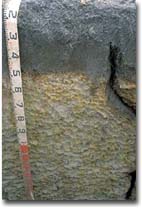Soil Glossary H-R
A-C | D-G | H-R | S-Z | References | Soil Homepage
HAPLIC: A term used in the Australian Soil Classification (Isbell, 2002) which indicates that the major part of the upper 0.5 m of the soil profile is whole coloured. It is used as the lowest order Subgroup distinction for a number of Soil Orders. Note: by lowest order, it is meant that the soil described matches none of the other Subgroup classes e.g. a Haplic, Epipedal, black Vertosol is not acidic, sodic, calcareous etc.
HARDSETTING: The condition of a soil where the surface is dry, hard and compacted with no apparent pedal development. These soils are not disturbed or indented by pressure of the forefinger. These harder setting soils tend to result in high runoff.
HORIZONS: Soil layers within the profile which are reasonably homogeneous in terms of morphological characteristics and properties (e.g. colour, texture, and structure) to the layers above and below.
A soil profile usually has these basic layers:
- A1 surface
- A2 subsurface
- B subsoil
- C substrate.
The horizon suffixes are as follows: See McDonald et al., 1990 for more detail.
- b - buried soil horizon (used in mineral soils only).
- c - iron, aluminium or manganese concretions or nodule accumulation.
- d - densipan (very fine sandy earthy pan).
- e - conspicuously bleached horizon.
- f - faunal accumulations e.g. worm casts, dominating A1 horizons.
- g - strong gleying.
- h - accumulation of amorphous organic matter where aluminium dominates over iron.
- j - sporadically bleached horizon.
- k - large accumulation of carbonates, commonly calcium carbonates.
- m - strong cementation.
- p - any disturbance by man e.g. ploughing.
- q - accumulation of secondary silica, qm is used for near continuous silica cementation.
- r - layers of weathered rock that can be dug with hand tools.
- s - an accumulation of sesquioxide organic matter where iron dominates over aluminium.
- t - accumulation of silicate clay.
- w - development of color and/or structure in the B Horizon with little or no accumulation of sesquioxide organic matter complexes.
- x - fragipan or earthy pan.
- y - large accumulation of calcium sulphate (gypsum) in B Horizon.
HUMOSE HORIZON: A humus rich surface or near surface horizon that is at least 20 cm thick and has an organic carbon content of more than 4% for sandy soils and greater than 6% for clayey soils. This term is used as a Subgroup distinction for a number of Soil Orders in the Australian Soil Classification (Isbell, 2002).
HUMOSESQUIC: Soils with only a Bhs Horizon within Aeric or Semiaquic conditions. This term is used as a Great Group definition for the Podosol Order in the Australian Soil Classification (Isbell, 2002).
| HYDROSOLS: Soil Order of the Australian Soil Classification (Isbell, 2002). These are soils where a greater part of the profile is saturated for at least several months per year. | 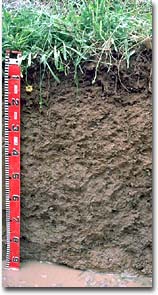 |
HYPERCALCIC: These soils have a Bk Horizon or a subsurface layer containing more than 20% soft, finely divided carbonate, less than 20% hard calcrete fragments and/or carbonate nodules, and/or carbonate coated gravel. The term is used as a definition for a number of Orders in the Australian Soil Classification (Isbell, 1996).
HYPERNATRIC: The major part of the upper 0.2 m of the B2 Horizon has an ESP greater than 25. This term is used as a Great Group definition for the Sodosol Order in the Australian Soil Classification (Isbell, 2002).
HYPOCALCIC: Soils where the carbonate in the B or B/C Horizon is evident only by using acid treatment, or is in the form of a few soft visible segregations with few if any hard nodules or concretions. This term is used as a definition for a number of soils in the Australian Soil Classification (Isbell, 2002).
ILLUVIATION: The process of deposition (in-washing) of soil materials either from suspension or solution, usually from an upper horizon into a lower soil horizon but also from a lateral source (Allaby, 1991).
INDURATED: Hardened soil particles (see Cemented).
INFILTRATION: The movement of water through the soil surface. Soils with a high infiltration capacity allow more rain to enter the soil than those with a low infiltration capacity. Runoff will occur when the rate of rainfall exceeds the soil's infiltration capacity. Surface soil structure and texture are important determinants of the infiltration capacity of a soil.
INTRACTABLE: Tough consistence, hard to work.
KANDOSOLIC: A term used in the Australian Soil Classification (Isbell, 2002). to classify Hydrosols. This indicates that the soil would otherwise be classified as a Kandosol apart from the fact that it is saturated in the greater part of the profile for prolonged periods (i.e. 2-3 months) in most years - therefore making it a Hydrosol.
KANDOSOLS: A Soil Order of the Australian Soil Classification (Isbell, 2002). These soils lack strong texture contrast and have massive or only weakly structured B horizons. The B2 horizon is well developed and has a maximum clay content in some part of the B2 Horizon which exceeds 15%. They are also not calcareous throughout.
KRASNOZEM: A Great Soil Group (Stace et al.,1968). These soils are typically red, deep, well-structured, acid and porous soils. They have relatively high clay contents and tend to display a gradual increase in clay with depth.
KUROSOLS: A Soil Order of the Australian Soil Classification (Isbell, 2002). These soils have a clear or abrupt textural change at the A/B boundary. The upper B2 horizon is strongly acidic i.e. less than 5.5 in water.
KUROSOLIC: A Great Group description related to Hydrosols in the Australian Soil Classification. Refers to Hydrosols that have a clear or abrupt textural B horizon and the major part of the upper 20 cm of the B2 horizon is strongly acid.
LABILE: Loss of consistence, pieces break off the aggregate when it is dry and when it becomes moist the pieces stick back together.
LACUSTRINE: A geomorphic process whereby soil forming material is deposited in lakes.
LAND CAPABILITY: The ability of a piece of land to sustainably support a specific land use. It is an expression of the effect of the physical components of the land -especially the soil, but including climate - on determining whether a specific land use is likely to cause damage. If land is used beyond its capability, degradation results.
LATERITE: Refers to a soil profile with horizon/s rich in iron oxides. This is usually associated with deeply weathered profiles. The process whereby laterite is formed, is referred to as laterization. Laterization developed predominantly in the early Tertiary period when Australia experienced a warm, wet climate.
LATERITIC PODSOLIC: Great Soil Group Classification, (Stace et al., 1968). These soils are strongly leached with a strong texture contrast between thick sandy A horizons and mottled yellow-brown and red clay B horizons. Nodular pisolitic (secondary concretion generally of a greater length to width ratio e.g. bullet shape.) or massive ironstone occurs at the base of the bleached A2 horizon and in the upper B2 horizon. The pH trend is acid throughout the profile.
LEACHING: The removal in solution of soluble minerals and salts as water moves through the profile.
LENTICULAR STRUCTURE: Soil particles that are arranged around an elliptical or circular plane and are bounded by curved faces i.e. lens shaped. This structure often occurs in subsoils of Vertosols and can be associated with slickenside development.
LEPTIC:Relates to Rudosols and Tenosols in the Australian Soil Classification (ASC) - that are underlain within 0.5 m of the surface by a calcrete pan.
LEVEE: A natural levee is a deposit of alluvium which is raised above the general level of the banks of a stream and its flood plain. Man-made levees may be constructed along the course of a river or stream in order to contain flood waters.
LIME: A naturally occurring calcareous material used to raise the pH of an acidic soil and/or supply calcium for plant growth. It is effective for treating acidic soils.
LITHIC: Refers to soils in which the B Horizon directly overlies hard rock. This term is used to describe Tenosols, Calcarosols, Organosols and Rudosols in the Australian Soil Classification (Isbell, 2002).
LITHOCALCIC: Describes soils with a calcareous horizon containing more than 50% of hard calcrete fragments and/or carbonate nodules or concretions and/or carbonate-coated gravel. It is used to describe Calcarosols, Chromosols, Dermosols, Kandosols and Sodosols using the Australian Soil Classification (Isbell, 2002).
LUNETTES: Crescent shaped aeolian deposits of fine sediment located on the eastern (or lee) side of lake beds or playas in semi-arid areas of southern Australia.
MAGNESIC: Soils with an exchangeable Ca/Mg ratio of less than 0.1 in the major part of the B2 Horizon. This term is used as a definition within a number of Soil Orders in the Australian Soil Classification (Isbell, 2002). These soils can often be strongly weathered.
MANGANIC: A horizon with a minimum thickness of 0.1 m that contains 20% or more (by weight or visual estimate) of black manganiferous nodules or concretions which are generally uncemented. Most nodules contain some iron. This term is used as a Subgroup definition for a number of Orders in the Australian Soil Classification (Isbell, 2002).
MASSIVE: This term applies to soil horizons greater than 6 mm in thickness, that appear to be coherent or solid and devoid of peds. When displaced, the soil separates into fragments which may be crushed into individual particles.
MELACIC: These soils are similar to Melanic but the pH (1:5 water) is less than 5.5 and there is no structure requirement. It is a subgroup of the Australian Soil Classification (Isbell, 2002).
MELANIC: These soils have either a dark coloured (i.e. Munsell (1992) colour value 3 or less and chroma 2 or less) surface or near surface horizon that has insufficient organic carbon to qualify as a humose horizon, with little or no evidence of stratification (layers). It is used as a Subgroup definition for a number of Orders in the Australian Soil Classification (Isbell, 2002).
MESONATRIC: In these soils, a major part of the upper 0.2 m of the B2 Horizon has an ESP between 15-25. Used as a Great Group definition for Sodosols in the Australian Soil Classification (Isbell, 2002).
MESOTROPHIC: See Base Status.
MOTTLING: The presence of more than one soil colour in a horizon. The soil may differ in colour either within peds or aggregates, or between them. Mottling occurs as blotches or streaks of subdominant colour throughout the main (i.e. matrix) colour. It does not refer to stains or coloured deposits on ped faces. Mottling is often an indication of poor profile drainage but may be caused by the weathering of parent material. Diffusely mottled implies that neighbouring colours are only slightly different.
MYCORRHIZAE: Means 'fungus root'. These are soil fungi that infect plant roots and produce a symbiotic relationship. The fungi acts as rootlets and increases the surface area available for contact with nutrients (particularly phosphorus and zinc) by ten fold. The mycorrhizae then makes these nutrients available to the plant. In exchange the plant gives back sugars to sustain the fungi, as it doesn't photosynthesis (Coyne, 1999). Fallowing, excessive tillage and soil fumigation can cause mycorrhizae to die out. Some plants such as rapeseed do not need mycorrhizae and therefore the mycorrhizae tends to die out of the soil. Plants growing with mycorrhizae are generally healthier and more resistant to root disease and root rot.
NATRIC: Soils where the major part of the upper 0.2 m of the B2 Horizon is sodic. Used as a Great Group definition for Hydrosols and Kurosols in the Australian Soil Classification (Isbell, 2002).
NORTHCOTE FACTUAL KEY: See Factual Key (Northcote, 1979).
NUTRIENT DEFICIENCY: Where the availability of an essential element is low and causes a reduction in plant growth, and interference with the life cycle of that plant.
Many soil factors are associated with low availability of nutrients. Usually it is due to low levels of the nutrient, but it may also be due to acidity influenced availability, low nutrient solubility, or immobilisation within organisms and organic matter.
NUTRIENT STATUS: Can be used as a rough guide to the availability of nutrients to plants. It is calculated as the sum of exchangeable calcium, magnesium and potassium (in milliequivalents per 100 g).
The categories used are:
- very low (0 - 3.9);
- low (4 - 7.9);
- moderate (8 - 17.9);
- high (>18) (Lorimer and Rowan, 1982).
O HORIZONS: Horizons dominated by decomposing organic materials that have accumulated on the mineral soil surface (McDonald et al., 1990). This horizon is divided up into O1 and O2 horizons.
ORGANIC MATERIALS: Plant derived organic accumulations.
ORGANOSOLS: Soils that are dominantly made up of organic materials. A Soil Order of the Australian Soil Classification (Isbell, 2002).
ORTHIC: This term is used to describe Tenosols in the Australian Soil Classification (Isbell, 2002).
It refers to soils with a B Horizon:
- that is weakly developed in terms of colour, structure, texture and segregations;
- or a B2 Horizon with less than 15% clay;
- or a transitional horizon (C/B) occurring in fissures in the parent rock or weathered rock.
PANS: Hard or cemented layers interfering with air, water and root penetration.
PARAPANIC: A term used as a Subgroup definition for Podosols in the Australian Soil Classification (Isbell, 2002). It refers to soils with a strongly coherent (i.e. consistence 4-5) B Horizon e.g. Parapanic, Pipey, Semiaquic PODOSOL.
PARENT MATERIAL: The rock from which a soil profile develops.
PARNA: Is a fine textured calcareous deposit of aeolian origin. It is postulated to be derived from older soils and transported mostly in the form of small aggregates, during an earlier more arid period.
PARTICLE SIZE ANALYSIS: The measurement of the relative amounts of coarse sand, fine sand, silt and clay size particles in a soil sample (as determined in the laboratory). Also called 'mechanical analysis'.
| Coarse sand | 0.2 – 2 mm |
| Fine Sand | 0.02-0.2 mm |
| Silt | 0.002-0.02 mm |
| Clay | < 0.002 mm |
Standard particle size classes used in Australia as per Marshall (1947).
See chart and texture triangle in McDonald et al (1990) Soil and Land Survey Field Handbook 2nd Edition; pp116-117
PED: The natural unit of soil structure formed by the soil's tendency to fracture along planes of weakness.
PEDAL: A general soil science term indicating that soil structure is present. In the Australian Soil Classification (Isbell, 2002), pedal is used as a Great Group class for Calcarosols - where the subsoil (B) horizon has a grade of structure that is stronger than weak.
PEDOGENIC: Material formed by pedological processes (formed within the soil, not by deposited material) e.g. buckshot forms within a soil from iron rich materials due to drainage and ground water conditions over time.
PETROCALCIC: Soils with a B Horizon that directly overlies a calcrete pan. This term is used as a Great Group or Subgroup distinction for a number of Soil Orders in the Australian Soil Classification (Isbell, 2002).
PETROFERRIC: These soils have ferruginous or ferromanganiferous nodules or concretions cemented into indurated blocks or large irregular fragments. Used as a Great Group definition for a number of Orders in the Australian Soil Classification (Isbell, 2002).
P HORIZONS: Commonly known as peat. These horizons, dominated by decomposing organic matter have accumulated under water or excessive wetness (McDonald et al., 1990). P Horizons are further divided into P1 and P2.
pH (SOIL): This is a measure of soil acidity and soil alkalinity on a scale of 0 (extremely acidic) to 14 (extremely alkaline). A pH of 7 is neutral. pH gives an indication of the availability of plant nutrients and relates to the growth requirements of particular crops. In most agricultural soils, pH is usually between 4 and 8.5. Excessive acidity or alkalinity makes the soils inhospitable for plant and microbial growth. Microorganisms don't flourish in low pH and enzyme activity also changes with the change in pH. Aluminium and Manganese solubility increases in acidic soils and becomes toxic to microorganisms (Coyne, 1999). Acid soils are usually deficient in necessary nutrients e.g. calcium and magnesium.
PIPEY (B HORIZON): These horizons are characterised by 'pipes' of bleached A2 horizon that penetrate (mostly vertically) into the B horizon. This results in a tongued A/B boundary on a profile face. The presence of a pipey horizon is used at the Great Group level within the Podosol Order of the Australian Soil Classification (Isbell, 2002), e.g. Parapanic, Pipey, Semiaquic PODOSOL.
PISOLITH: Rock particle 1-10 mm in diameter with an internal structure of concentric laminae (i.e. peel off).
PLANT AVAILABLE WATER CAPACITY (PAWC): The amount of soil water that can be extracted by the plant. It is defined as the difference in soil moisture content between the field capacity and the wilting point. It is expressed as millimetres of plant-available water within the root zone.
PLASTIC LIMIT: The water content of the soil above which the soil will compress and shear when compacted, leading to structural degradation occurring.
PLASTIC SOILS: A soil capable of being moulded or permanently deformed in shape without a change in volume, rebound or texture.
PLAYA: A large, shallow closed depression which is intermittently filled with water but is mainly dry due to evaporation. These are often former lake beds. A lunette will usually be present on the eastern margin of the playa.
PODOSOL: These soils have a B Horizon dominated by the accumulation of compounds of organic matter, aluminium and/or iron. These horizons may occur individually or in combination within a profile. A Soil Order of the Australian Soil Classification (Isbell, 2002). These soils have been previously referred to as Podzols using the former Great Soil Group classification system.
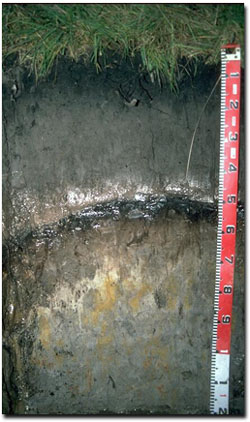 Site SG9 Profile |
The SG9 pit site is an example of a Podosol that has both a Bh and a Bhs horizon. <-- 50-55 cm - Bh - dominated by organic compounds. <-- 55-65 cm - Bhs - dominated by aluminium and organic compounds. |
POLYHEDRAL STRUCTURE: A soil structural unit whereby soil particles are arranged around a point and bounded by more than six relatively flat but dissimilar faces.
POROSITY (SOIL): The degree of pore space in a soil i.e. the percentage of the total space between solid particles.
PRIOR STREAM: The course of a former stream responsible for the nearby sediments that did not carry water other than local drainage. A low ridge built up from materials deposited by stream flow along a former stream channel (McDonald et al., 1990).
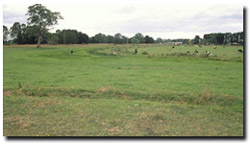 Prior stream channel south of Tinamba in West Gippsland. |
| PRISMATIC STRUCTURE: A soil structural unit whereby soil particles are arranged around a vertical axis and bounded by relatively flat faces. The top of the prisms are also relatively flat. Prismatic structure is often associated with subsoil sodicity. | ||
 | Prismatic structure in the subsoil (from 55 cm depth) of a Chromosol in the Corangamite region. | 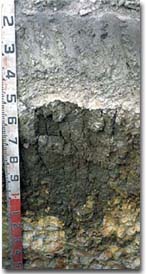 |
PROFILE: The vertical section of the soil from the soil surface down through the horizons including the parent material. It consists of two parts: the solum and the parent material.
RED-BROWN EARTHS: Great Soil Group Classification (Stace et al., 1968). The surface soil is moderately thick and mildly acid to neutral, and the B Horizons are usually alkaline and may contain carbonates. These soils are typical of semiarid to subhumid climates and develop on various parent materials.
The characteristic features of a red-brown earth include:
- an A horizon which is grey-brown to red-brown loamy sand to sandy clay loam;
- an A horizon which is weakly structured to massive;
- an abrupt to clear boundary between the A and B horizons;
- a B horizon with a brighter brown to red clay and a well developed medium prismatic to blocky structure.
REGOLITHIC: Relates to Calarosols, Organosols and Tenosols in the Australian Soil Classification (ASC) - that directly overlie unconsolidated mineral materials.
| RETICULATE MOTTLING: Soil horizons which have strongly developed reddish, yellowish, greyish or white mottling that forms a 'net' or 'mesh' type pattern. | 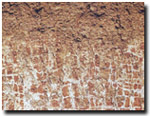 Reticulate Mottling. |
RHYZOBIA: Rhyzobium is a genus of bacteria which can colonise root hairs on legumes and consequently provide nitrogen to the host plant by converting atmospheric nitrogen to a form subsequently useable by host.
The bacterial colonisation occurs in only some of the root hairs and nodules form as an outgrowth of the hairs.
The effectiveness of this relationship in providing a nitrogen supply to the host plant varies considerably.
R HORIZONS: These horizons contain continuous rock of a moderately strong to very strong nature such as bedrock (McDonald et al., 1990).
RUDOSOLS: These soils have limited pedological organisation as well as minimal development of the A1 horizon. A Soil Order of the Australian Soil Classification (Isbell, 2002).

